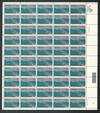
# 2091 - 1984 20c Saint Lawrence Seaway
U.S. #2091
1984 20¢ Saint Lawrence Seaway
- Issued for the 25th anniversary of the St. Lawrence Seaway
- Fourth US joint issue with Canada
Stamp Category: Commemorative
Value: 20¢, rate for first-class mail
First Day of Issue: June 26, 1984
First Day City: Massena, New York
Quantity Issued: 120,000,000
Printed by: American Bank Note Company
Printing Method: Photogravure
Format: Panes of 50 in sheets of 200
Perforations: 11
Joint Issue: Canada #1015
Why the stamp was issued: To commemorate the 25th anniversary of the St. Lawrence Seaway
About the stamp design: Both the US and Canada stamps were designed by Canadian graphic artist Ernst Barenscher. The US stamp pictures an aerial view of the St. Lawrence Seaway. The Canada stamp is larger and shows a cross section of the entire seaway. A red dot was placed at the location of the Cornwall headquarters of the seaway, to honor that city’s 200th anniversary which also occurred in 1984.
First Day City: This stamp’s first day ceremony was held in Massena, New York, which was the same town where the 1959 St. Lawrence Seaway stamps had been issued 25 years earlier. The Canada stamp was issued in Cornwall, Ontario, and both nations sold each other’s stamps and First Day Covers.
Unusual fact about this stamp: This was the second US stamp in 25 years to honor the St. Lawrence Seaway. The US Post Office generally preferred to honor subjects on even anniversaries (50th, 100th, etc), but made an exception for the St. Lawrence Seaway. The 1959 stamp (US #1131) was America’s first-ever joint issue. The 1959 Canada stamp was #387. Click here for more about those joint issues.
History the stamp represents: On April 25, 1959, the St. Lawrence Seaway opened, connecting the Great Lakes to the Atlantic Ocean.
The first proposals for a deep waterway linking the Atlantic Ocean to the Great Lakes were considered in the 1890s. It took more than a half-century to turn the ideas into reality.
The joint effort between Canada and the US finally received authorization to begin in 1954, when the St. Lawrence Seaway Development Corporation was formed. Construction of the St. Lawrence Seaway was nearly as ambitious as the Panama Canal project. Several villages and hamlets were flooded, and new towns were built for 6,500 displaced residents.
The existing system of smaller waterways was excavated, altered, or replaced by a single system 27 feet deep. At the time, the St. Lawrence Seaway was widely considered to be the largest work of engineering of all time. In addition to building locks and channels, hydroelectric plants were also constructed, reaching a total cost of $470 million.
The seaway opened on April 25, 1959, with the icebreaker D’Iberville making the first transit. Three months later, on June 26, Queen Elizabeth II and President Dwight Eisenhower presided over the formal dedication ceremony attended by some 20,000 people. After the ceremony, they boarded the Royal Yacht Britannia and entered the lift locks.
The St. Lawrence Seaway became a major commercial shipping route linking the Atlantic Ocean and the Great Lakes. The seaway extends from Montreal westward to the eastern shore of Lake Erie. It is formed by the St. Lawrence River, several lakes, and a system of canals and locks. In total, the seaway has about 65 miles of canals, plus 15 locks and three dams. Before the seaway was opened in 1959, cargo ships could not navigate many parts of this route, due to shallow or rough waters and changes in elevation.
Additionally, the seaway includes a hydroelectric dam that supplies power to parts of Ontario and New York. This dam created Lake St. Lawrence, which is more than 30 miles long. The hydroelectric project began producing power in 1958.
A joint project, Canada administers about 55 miles of canals and 13 locks while the US runs 10 miles of canals and two locks. The Saint Lawrence Seaway is the world’s longest deep-draft inland waterway. The seaway extends 2,038 nautical miles from the Atlantic Ocean at Montreal to Lake Superior. The series of canals that form the seaway permits ocean-going vessels to receive and deliver goods in 15 ports in the US and Canada. In addition to shipping goods from America’s heartland, the seaway also plays an important role in recreation and tourism.
The St. Lawrence Seaway is generally open for navigation from April to December. On average, 50 million tons of cargo passes through the seaway every year. Approximately 40,000 jobs depend on the seaway, which supports a vast array of industries. Grain from American and Canadian prairies is carried to the international market via the seaway and accounts for 40% of the total cargo. Iron ore, coal, and steel are also carried to various ports along the seaway. Today, shipping on the 2,300-mile waterway generates over $3 billion annually for the US.
U.S. #2091
1984 20¢ Saint Lawrence Seaway
- Issued for the 25th anniversary of the St. Lawrence Seaway
- Fourth US joint issue with Canada
Stamp Category: Commemorative
Value: 20¢, rate for first-class mail
First Day of Issue: June 26, 1984
First Day City: Massena, New York
Quantity Issued: 120,000,000
Printed by: American Bank Note Company
Printing Method: Photogravure
Format: Panes of 50 in sheets of 200
Perforations: 11
Joint Issue: Canada #1015
Why the stamp was issued: To commemorate the 25th anniversary of the St. Lawrence Seaway
About the stamp design: Both the US and Canada stamps were designed by Canadian graphic artist Ernst Barenscher. The US stamp pictures an aerial view of the St. Lawrence Seaway. The Canada stamp is larger and shows a cross section of the entire seaway. A red dot was placed at the location of the Cornwall headquarters of the seaway, to honor that city’s 200th anniversary which also occurred in 1984.
First Day City: This stamp’s first day ceremony was held in Massena, New York, which was the same town where the 1959 St. Lawrence Seaway stamps had been issued 25 years earlier. The Canada stamp was issued in Cornwall, Ontario, and both nations sold each other’s stamps and First Day Covers.
Unusual fact about this stamp: This was the second US stamp in 25 years to honor the St. Lawrence Seaway. The US Post Office generally preferred to honor subjects on even anniversaries (50th, 100th, etc), but made an exception for the St. Lawrence Seaway. The 1959 stamp (US #1131) was America’s first-ever joint issue. The 1959 Canada stamp was #387. Click here for more about those joint issues.
History the stamp represents: On April 25, 1959, the St. Lawrence Seaway opened, connecting the Great Lakes to the Atlantic Ocean.
The first proposals for a deep waterway linking the Atlantic Ocean to the Great Lakes were considered in the 1890s. It took more than a half-century to turn the ideas into reality.
The joint effort between Canada and the US finally received authorization to begin in 1954, when the St. Lawrence Seaway Development Corporation was formed. Construction of the St. Lawrence Seaway was nearly as ambitious as the Panama Canal project. Several villages and hamlets were flooded, and new towns were built for 6,500 displaced residents.
The existing system of smaller waterways was excavated, altered, or replaced by a single system 27 feet deep. At the time, the St. Lawrence Seaway was widely considered to be the largest work of engineering of all time. In addition to building locks and channels, hydroelectric plants were also constructed, reaching a total cost of $470 million.
The seaway opened on April 25, 1959, with the icebreaker D’Iberville making the first transit. Three months later, on June 26, Queen Elizabeth II and President Dwight Eisenhower presided over the formal dedication ceremony attended by some 20,000 people. After the ceremony, they boarded the Royal Yacht Britannia and entered the lift locks.
The St. Lawrence Seaway became a major commercial shipping route linking the Atlantic Ocean and the Great Lakes. The seaway extends from Montreal westward to the eastern shore of Lake Erie. It is formed by the St. Lawrence River, several lakes, and a system of canals and locks. In total, the seaway has about 65 miles of canals, plus 15 locks and three dams. Before the seaway was opened in 1959, cargo ships could not navigate many parts of this route, due to shallow or rough waters and changes in elevation.
Additionally, the seaway includes a hydroelectric dam that supplies power to parts of Ontario and New York. This dam created Lake St. Lawrence, which is more than 30 miles long. The hydroelectric project began producing power in 1958.
A joint project, Canada administers about 55 miles of canals and 13 locks while the US runs 10 miles of canals and two locks. The Saint Lawrence Seaway is the world’s longest deep-draft inland waterway. The seaway extends 2,038 nautical miles from the Atlantic Ocean at Montreal to Lake Superior. The series of canals that form the seaway permits ocean-going vessels to receive and deliver goods in 15 ports in the US and Canada. In addition to shipping goods from America’s heartland, the seaway also plays an important role in recreation and tourism.
The St. Lawrence Seaway is generally open for navigation from April to December. On average, 50 million tons of cargo passes through the seaway every year. Approximately 40,000 jobs depend on the seaway, which supports a vast array of industries. Grain from American and Canadian prairies is carried to the international market via the seaway and accounts for 40% of the total cargo. Iron ore, coal, and steel are also carried to various ports along the seaway. Today, shipping on the 2,300-mile waterway generates over $3 billion annually for the US.










